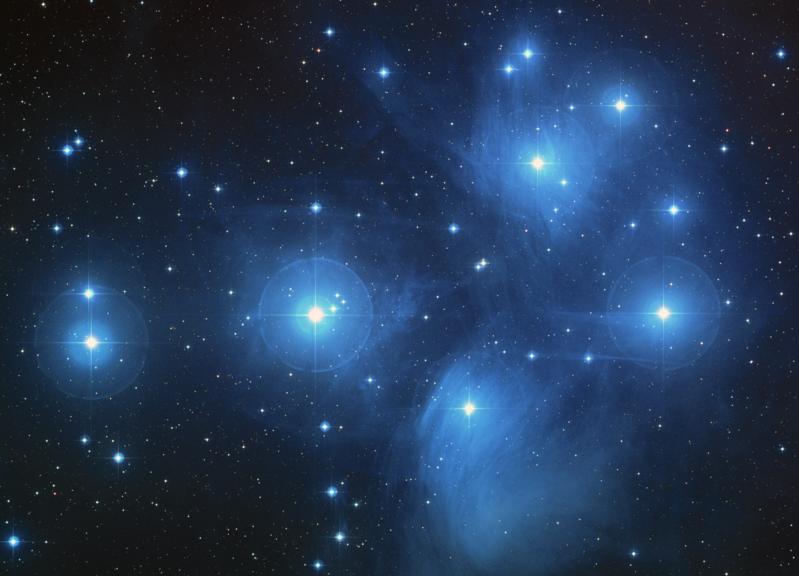







| BOOKS | F. A. Q. | ARTICLES | TALKS | ABOUT KEN | DONATE | BEYOND OUR KEN |
|---|
By Ken Croswell
Published on ScienceNOW (August 28, 2014)

Credit: NASA, ESA, and AURA/Caltech.
Visible to the naked eye and a stunning sight through binoculars, the Pleiades star cluster seems an unlikely place for controversy. Yet for two decades debate has raged over how far the cluster is from Earth. Now radio astronomers claim they have determined a definitive distance, but their result contradicts a European satellite whose chief mission was measuring stellar distances�and illustrates how a newly launched spacecraft may soon provoke controversy itself.
Distance is crucial in astronomy. Without knowing a star's distance, you don't know how powerful it is. If a star is twice as far as you had thought, it emits four times more light than you thought. The Pleiades cluster is young and nearby, so it gives astronomers the chance to study stars that are just starting their lives. But the stars' luminosities, diameters, and ages are elusive without knowing the cluster's distance.
The platinum standard for measuring stellar distance is parallax. This is the small apparent movement a star exhibits each year because observers view it from slightly different perspectives as Earth circles the Sun. The farther the star, the smaller is the parallax.
Parallax is so vital that in 1989 the European Space Agency (ESA) launched the Hipparcos satellite, which measured parallaxes of more than 100,000 stars. Unfortunately, a booster aboard the satellite failed to fire, leaving the satellite in a highly elliptical orbit around Earth and complicating analysis of the data. The Pleiades controversy erupted in 1997, when Hipparcos scientists released the parallax data and said the cluster was much closer to us than had been thought, implying that its stars were much less luminous and that stellar models were incorrect.
Now radio astronomers have joined the controversy. Carl Melis of the University of California, San Diego, and his colleagues linked 13 radio telescopes into an intercontinental array that yielded views so sharp they surpass the Hubble Space Telescope. As the scientists report online today in Science, they measured parallaxes of four Pleiads whose average distance turned out to be 444 light-years with an uncertainty of just 4 light-years�a far greater distance than the figure of 392 light-years that Hipparcos scientists favor.
"They don't really have a leg to stand on anymore," Melis says. "This should be the end of it."
Not so, counters Floor van Leeuwen of the University of Cambridge in the United Kingdom, the astronomer who has defended the Hipparcos result for the last 17 years. "I don't think it resolves anything," he says. "They've got four stars," whereas Hipparcos used 53. But Melis says his parallaxes are much more precise than those from Hipparcos and agree with other non-Hipparcos parallaxes.
Astronomer Marc Pinsonneault of Ohio State University, Columbus, has no connection to Hipparcos or the radio astronomers who did the new research. "I think this is actually a very nice piece of work," he says. "It's an independent technique, and one that is quite precise." Pinsonneault suspects Hipparcos erred because of its unfortunate orbit; although scientists tried to correct for this problem, he says the Pleiades lies in a part of the sky where the correction was difficult to measure. Also, the cluster is sufficiently distant that its parallax is small, making it hard to measure as well.
All three scientists agree on what it will take to resolve the controversy: Gaia, a powerful new spacecraft that ESA launched last December, will measure parallaxes of a billion stars�including hundreds in the Pleiades�so that by the end of the decade we should finally know how far the cluster is from Earth. Whatever the final outcome, however, the ongoing debate over the Pleiades suggests that Gaia itself may provoke controversy when it measures distances to stars at the far end of its vision, if the findings contradict what astronomers thought they knew.
Ken Croswell earned his Ph.D. in astronomy from Harvard University and is the author of The Alchemy of the Heavens and The Lives of Stars.
"An engaging account of the continuing discovery of our Galaxy...wonderful." --Owen Gingerich, The New York Times Book Review. See all reviews of The Alchemy of the Heavens here.
"A stellar picture of what we know or guess about those distant lights."--Kirkus. See all reviews of The Lives of Stars here.
| BOOKS | F. A. Q. | ARTICLES | TALKS | ABOUT KEN | DONATE | BEYOND OUR KEN |
|---|